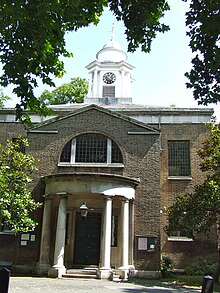St Mary on Paddington Green is an Anglican church in the Parish of Little Venice, London, and forms part of Paddington Green conservation area. Today it stands at the junction of Edgware Road and Harrow Road, overlooking the East end of Westway and the approaches to Marylebone Flyover, so seen by tens of thousands of motorists daily.[1]
| St Mary on Paddington Green | |
|---|---|
 | |
 | |
| 51°31′13″N 0°10′31″W / 51.5204°N 0.1753°W | |
| Location | Little Venice, London, W2 1NB |
| Country | England |
| Denomination | Church of England |
| Churchmanship | Anglo-Catholic |
| Website | parishoflittlevenice.com |
| History | |
| Status | Active |
| Architecture | |
| Functional status | Parish Church |
| Administration | |
| Diocese | Diocese of London |
| Episcopal area | Two Cities (London and Westminster) |
| Archdeaconry | Archdeaconry of Charing Cross |
| Deanery | Westminster Paddington |
| Parish | Little Venice |
| Clergy | |
| Bishop(s) | The Rt Revd Sarah Mullally (Bishop of London) |
| Vicar(s) | Fr Gary Bradley |
| Assistant priest(s) | Fr Andrew Norwood |
| Laity | |
| Director of music | Jonathan Cunliffe |
| Churchwarden(s) | Miles Williams and Reina Tan |
History
editThe present building is the third church on the site, once forming a centrepiece of the ancient villages of Paddington and Lilestone. John Donne preached his first sermon in the original church and William Hogarth was married in the second.[2]
The current Georgian church was commissioned in 1788 and consecrated in 1791. Designed by John Plaw with a Greek Cross ground plan, in yellow London stock brick dressed with white stone. It is one of two confirmed surviving buildings by Plaw in the UK, along with Belle Isle on Windermere.[3] A further building in Romford, known as The Round House, has been attributed to him.[4] John Plaw later worked in Southampton before emigrating to Canada, where he designed several public and private buildings.[5]
The church was altered in the 19th century but was restored to its mid-Georgian appearance by architect Raymond Erith in the early 1970s using some of the compensation for the construction of the urban motorway Westway, alongside the church. Restoration included the chancel being reinstated in its original form, the nave reseated with box pews and the organ moved to the West end.[6] The organ case is dedicated as a memorial to Erith.[2] The church houses monuments to some of the area's residents, including sculptor Joseph Nollekens and lexicographer Peter Mark Roget.
St Mary’s Churchyard
editThe adjoining churchyard was converted to a public park in the 1890s and is now known as St Mary's Gardens. It consists of grass with scattered trees. The grave of well-known 18th-century actress Sarah Siddons is located towards the northern end. Some headstones from the former churchyard are stacked against the west wall of the Gardens.[7]
The southern part of the churchyard was destroyed to make way for the approaches to Marylebone Flyover in the 1960s, with exhumed burials being reinterred in an area of Mill Hill cemetery and marked with a plaque.[7]
Notable burials
editRemaining churchyard
edit- Rev Dawson Burns (1828–1909), temperance leader
- William Chandless (1829–1896), Amazon explorer
- Rev Alexander Geddes (1737–1802), Biblical scholar
- Arthur Roberts (1852–1933), comedian
- Basil Owen Woodd (1760–1831), hymn writer (erected by the Crosse baronets)
- Leonard Charles Wyon (1826–1891), engraver and coin-designer
- Sir Stephen Spender (1909–1995), poet
- John Julius Norwich (1929–2018), historian, writer, and television personality
St Mary's Gardens
edit- Thomas Banks (1735–1805), sculptor
- Thomas Blore (1754–1818), historian
- William Collins RA (1788–1847), artist
- Matthew Dubourg (1703–1767), violinist
- Benjamin Haydon, (1786–1846) painter
- Joseph Nollekens (1737–1823), sculptor, and his father, Joseph Francis Nollekens, artist
- Emma Paterson (1846–1886), feminist and unionist
- Thomas Richmond (1771–1837), miniaturist
- Sarah Siddons (1755–1831), actress
- Charles Stedman (1753–1812), army officer
References
edit- ^ A Church Near You. "St Mary-on-Paddington Green, Paddington Green – London | Diocese of London". Achurchnearyou.com. Retrieved 15 January 2014.
- ^ a b Ben Weinreb and Christopher Hibbert, The London Encyclopaedia, Papermac, 1987, p. 743
- ^ "The Parish of Little Venice". The Parish of Little Venice. Retrieved 15 January 2014.
- ^ "Open House | Site Details – The Round House". Londonopenhouse.org. 20 August 2010. Retrieved 15 January 2014.
- ^ "Historic Properties Online: John Plaw". Gov.pe.ca. Retrieved 15 January 2014.
- ^ Lucy Archer, "Raymond Erith, Architect", 1985, p.205, ISBN 0907435041
- ^ a b "Westminster City Council – Paddington Green and St Mary's Churchyard". Westminster.gov.uk. 8 January 2009. Retrieved 15 January 2014.
External links
edit- Biographical information about John Plaw from Historic Places, Prince Edward Island, Canada
- Guide and map from City of Westminster
- Parish of Little Venice website